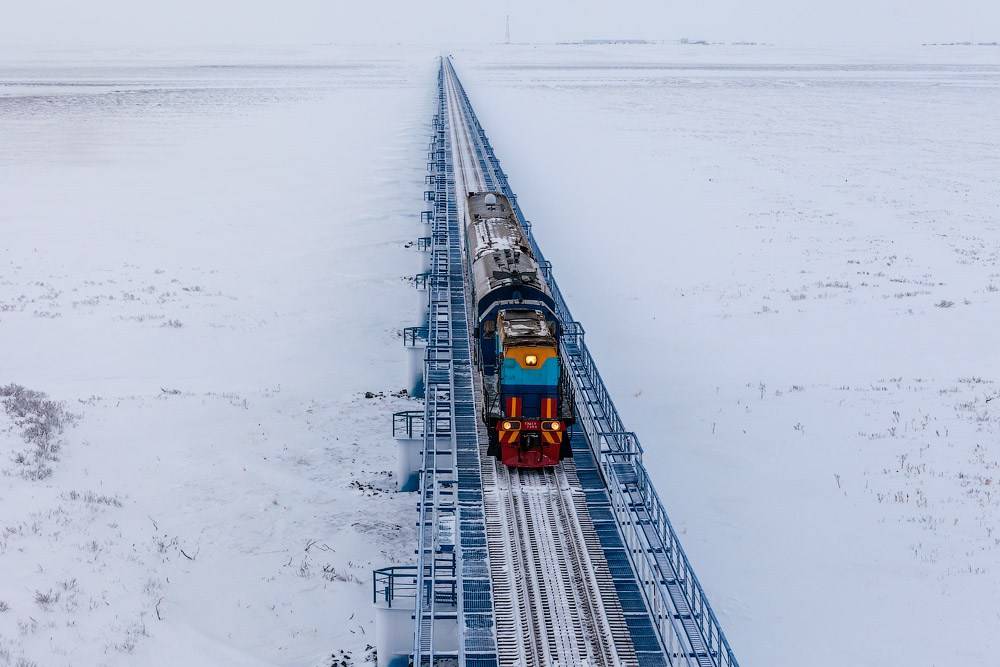News review of the events on the NSR
#2 April 2020
1. Atomflot and «Zvezda» Shipbuilding Complex sign contract for construction of «Leader» nuclear icebreaker
On April 23, a remote signing of the contract for the construction of the nuclear icebreaker “Leader” of project 10510 between Atomflot and “Zvezda” took place in Murmansk and Vladivostok.
The state customer for the construction of the icebreaker is Rosatom State Corporation, the developer is Atomflot, “Zvezda” Complex is the sole contractor for this contract. According to the terms, the commissioning of the vessel is scheduled for 2027.
“Today, an important step has been taken in the history of the nuclear icebreaker fleet,” commented Mustafa Kashka, director general of Atomflot. “Leader” will be equipped with two RITM-400 type nuclear reactors developed by Rosatom specialists. The total capacity of the icebreaker will be 120 MW, which will allow the vessel to overcome ice more than 4 meters thick. The commissioning of this nuclear icebreaker will allow Rosatomflot to guarantee safe and regular operations in the eastern region of the Arctic, provide year-round navigation in the waters of the Northern Sea Route, and open new opportunities for commercial high-latitude routes.”
2. Russia prepares new railway for the Northern Sea Route
The Russian government has begun considering the construction of railways to the Northern Sea Route as part of the new project “Siberian Meridian”, which was announced in 2019 by Russian President Vladimir Putin.
As part of the project, it is planned to implement previously planned construction projects, including the Northern Latitudinal Railway, as well as new lines in Siberia and the Arctic, thousands of kilometers long.
Preliminarily, the cost of “Siberian Meridian” project will amount to 4.93 trillion rubles. The project assumes that by 2035, between Russia and China, bypassing the Trans-Siberian Railway, freight traffic will be established, which will cover large sections in the Arctic and Siberia.
The construction of the double-track electrified railway ring will begin: Salekhard-Nadym-Urengoy-Surgut-Tyumen-Yekaterinburg-Perm-Yaroslavl-Obskaya-Salekhard.
The Russian President spoke about the development of this route in October last year, noting that this would relieve the Trans-Siberian Railway, provide the first clusters of the Angara-Yenisey region with transport capacities, contribute to the development of the Arctic transport hub, and also clear the way for passenger transport.
“Siberian Meridian” includes projects: the Northern Latitudinal Railway – Obskaya –
Salekhard-Nadym-Khorey and the Northern Latitudinal Passage-2 – Bovanenkovo-Sabetta, the Kyzyl-Kuragino section is proposed to be extended to the ArsSuuri border station, which will connect it to the designed line Mungan-Ovoot-Erdenet in Mongolia.
3. Putin signed law expanding list of LNG exporters
Russian President Vladimir Putin amended the law “On gas exports”, which expanded the list of companies that receive the right to export liquefied natural gas (LNG). The document, adopted by the State Duma on April 14 and approved by the Federation Council on April 17, was published on Friday on the official legal information portal. Prior to the adoption of the law, a number of “Novatek” projects, as well as the state-owned Rosneft and Gazprom, had the right to export LNG.
Changes to the law were made in order to fulfill the task of increasing the production of LNG in the Arctic, by granting the right to export LNG from sites which were licensed after January 1, 2013.
In the Russian market, Gazprom is a monopolist in gas exports through pipelines. The discussion on access to export markets of independent gas producers has been ongoing for several years. The first step towards liberalization was the permission to export LNG without the mediation of Gazprom. The right to export LNG was granted to companies whose license for the use of their resources as of January 1, 2013 provides for the construction of LNG plant or the transfer of produced gas for liquefaction to such a plant. At the end of 2013, Novatek, implementing “Yamal LNG” project, and Rosneft began to have this right.
4. Norilsk Nickel prepares to complete winter navigation
The polar transport branch of Norilsk Nickel company (in Dudinka) is preparing for the completion of the winter navigation and the beginning of the flood period. The winter navigation period started on November 1, 2019.
For six months, dock workers of the branch’s seaport handled 678 thousand tons of cargo for various purposes in both directions. Loading and unloading operations were performed on 39 vessels of Norilsk Nickel corporate fleet (five container ships and a tanker). Before the start of the inter-navigational pause, which lasts about a month, the port workers have to unload and load 8 more ships. Traditionally, about 80% of the cargo turnover is made up of materials and equipment owned by the company. The rest is household goods and food.
In April, 5 gantry cranes have already been lifted from the berths, which are traditionally flooded with melt waters. Prior to the start of the flood period, more than 8 thousand tons of cargo, several hundred containers with various material values, 12 Liebherr mobile port cranes and a significant number of port infrastructure facilities will be transported from production facilities that will sink under water.
According to preliminary forecasts of specialists, the flooding of the berths located at the 8-meter mark will begin from May 10-15. Floating of ice in the Dudinka area is expected from May 20 to 25.

